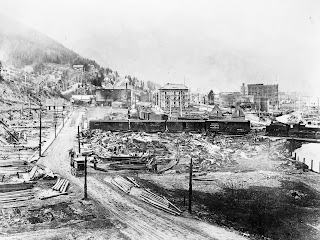The Great Fire of 1910
This area of northern Idaho and eastern Montana also played a big part in our nations conservation history but unfortunately a lot of it had to do with the Great Fire of 1910...it's causes, and there were several, and just as importantly how the nation responded.

At the turn of the century, the Idaho/Montana area was abundant with white pine trees and the demand was great. Much of the large forests in the east were already cut through but the west was still fertile and the lumber companies descended on this area in force. Cutting through forests with conservation and safety in mind was not exactly on the timber companies agenda. In fairness, as with almost any disaster, there was more than one factor involved with The Great Fire of 1910.
A Hot and Dry Summer Sets the Stage
The summer of 1910 was brutal. Rainfall was almost nonexistent. Everything dried up. It was the worst drought on record and temperatures were hot. At the same time, tracks had been laid for the Great Northern Railroad and the steam locomotives that started running through the area kicked off embers into the dry forest. Also, the worker camps established in the hills posed a fire threat simply because fire prevention was not a top priority with many inhabitants. A combination of drought, dry timber, high temperatures and industry all converged to cause the largest forest fire to date.
The New National Forest Service
The National Forest Service had just recently been established under the Roosevelt administration but it was underfunded and ran into political problems and the lumber industry as a whole was antagonistic to it's creation. In other words, the National Forest Service had an uphill battle in it's effort to enforce conservation as opposed to unregulated cutting. There were also conflicting opinions about forest fires themselves. Should they be left to burn naturally or be fought. After the fire of 1910 it was decided that all fires were to be fought and that remains the policy to this day. The Fire of 1910 was the decisive event that shaped public policy going forward. During this massive fire there was also a new fire fighting tool developed. The Pulaski Tool as some refer to it today was developed by a Forest Ranger named Edward Pulaski. Pulaski, while battling the blaze managed to save dozens of the men in his command and as a result came up with the Pulaski Tool which is still used today by our wildland fire fighters.
Several towns were destroyed including one-third of Wallace. Three million acres in all were burned. The fire lasted for two days and killed 87 people which included 78 fire fighters. The fire involved ten national forests and smoke from the disaster was eventually seen as far east as New York state. The army was brought in to help fight the fire including a contingent of the African-American Buffalo Soldiers.
(Photos from the public domain)
Here are websites that offer more information:
The Story of the Modern Day Smokejumpers
www.idahoforests.org
www.fs.fed.us
www.wallaceidahochamber.com


